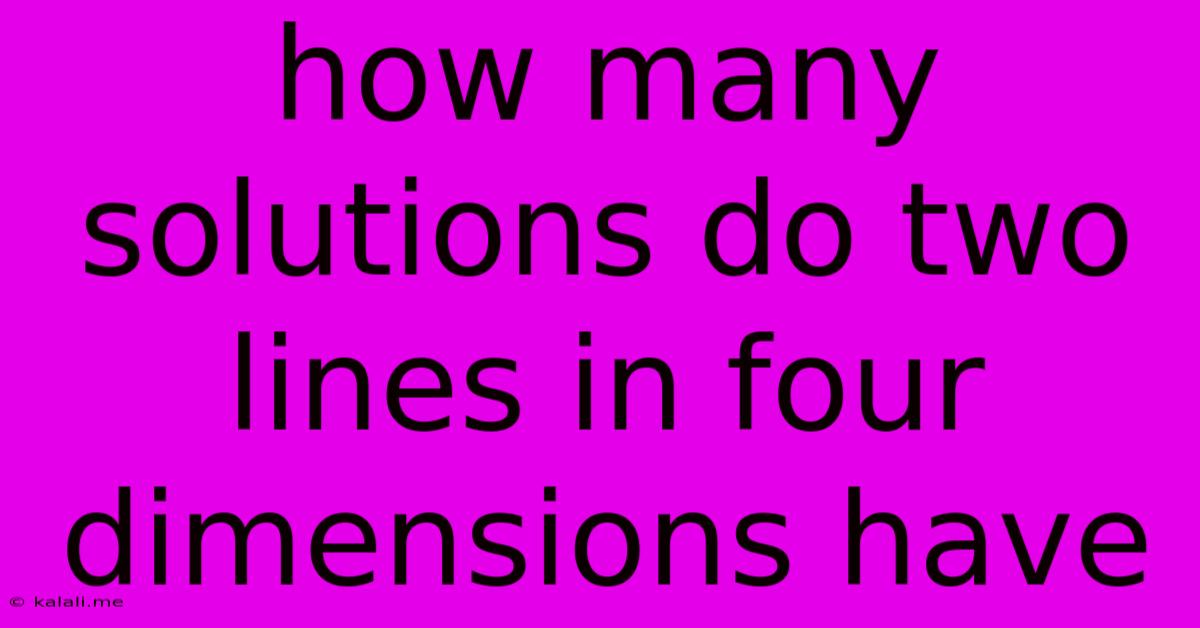How Many Solutions Do Two Lines In Four Dimensions Have
Kalali
Jun 06, 2025 · 3 min read

Table of Contents
How Many Solutions Do Two Lines in Four Dimensions Have?
This article explores the surprisingly nuanced answer to the question: how many solutions do two lines in four dimensions have? While seemingly a simple extension of two-dimensional geometry, the higher dimensionality introduces possibilities not present in our everyday experience. Understanding this requires a grasp of linear algebra and the geometric interpretation of systems of equations.
Lines in Higher Dimensions
In two dimensions, two lines can intersect at a single point, be parallel (no intersection), or be coincident (infinite intersections). Extending this to three dimensions adds the possibility of skew lines – lines that are not parallel but also do not intersect.
In four dimensions (and higher), the possibilities become even richer. We represent lines using parametric equations. A line in four-dimensional space can be defined by:
- x = a + lt
- y = b + mt
- z = c + nt
- w = d + pt
where (a, b, c, d) is a point on the line, (l, m, n, p) is the direction vector, and t is a parameter. Two lines, therefore, are represented by two sets of these equations.
Finding the Intersection: Solving a System of Equations
To find the intersection points of two lines in four dimensions, we need to solve the system of equations formed by equating the corresponding coordinates of the two lines. This leads to a system of four linear equations with two parameters (one for each line).
The number of solutions depends on the relationship between the direction vectors and the points defining the two lines. Here's a breakdown of the possibilities:
Possible Solutions:
-
Zero solutions (no intersection): This occurs when the lines are skew in four dimensions – they don't intersect and are not parallel. This is the most common case in higher dimensions. The system of equations will be inconsistent, meaning no values of the parameters will satisfy all equations simultaneously.
-
One solution (intersection at a point): This happens when the lines intersect at a single point in four-dimensional space. The system of equations has a unique solution for the parameters. This is analogous to intersecting lines in two or three dimensions.
-
Infinite solutions (coincident lines): This occurs when the two lines are actually the same line in four-dimensional space. They overlap completely, sharing all their points. The system of equations will have infinitely many solutions, representing the points along the single line.
The Key Role of Linear Independence
The key to determining the number of solutions lies in the linear independence of the direction vectors and the difference vector between a point on each line. If the direction vectors and the difference vector are linearly independent, the lines are skew and have no intersection. If they are linearly dependent, the lines either intersect at a single point or are coincident. Linear algebra provides the tools to analyze the linear dependence/independence of these vectors.
Conclusion: Beyond Simple Analogies
While the concepts of intersecting lines extend from two to four dimensions, the richer possibilities in higher-dimensional spaces emphasize the limitations of our intuition based solely on lower-dimensional experiences. The determination of the number of solutions requires a formal mathematical approach using linear algebra, highlighting the power and necessity of mathematical tools in understanding higher-dimensional geometry. The most likely outcome for two randomly chosen lines in four dimensions is that they will be skew, possessing no intersection points at all.
Latest Posts
Latest Posts
-
How I Met Your Mother Blue French Horn
Jun 06, 2025
-
Reduce The Frequency Range Of My Mic
Jun 06, 2025
-
Vocal Mixing Cross Fade Recommneded Length And Curve
Jun 06, 2025
-
How To Make Bike Go Backwards Instead Of Just Forwards
Jun 06, 2025
-
How To Find Heart Crystals Easily In Terraria Potion
Jun 06, 2025
Related Post
Thank you for visiting our website which covers about How Many Solutions Do Two Lines In Four Dimensions Have . We hope the information provided has been useful to you. Feel free to contact us if you have any questions or need further assistance. See you next time and don't miss to bookmark.